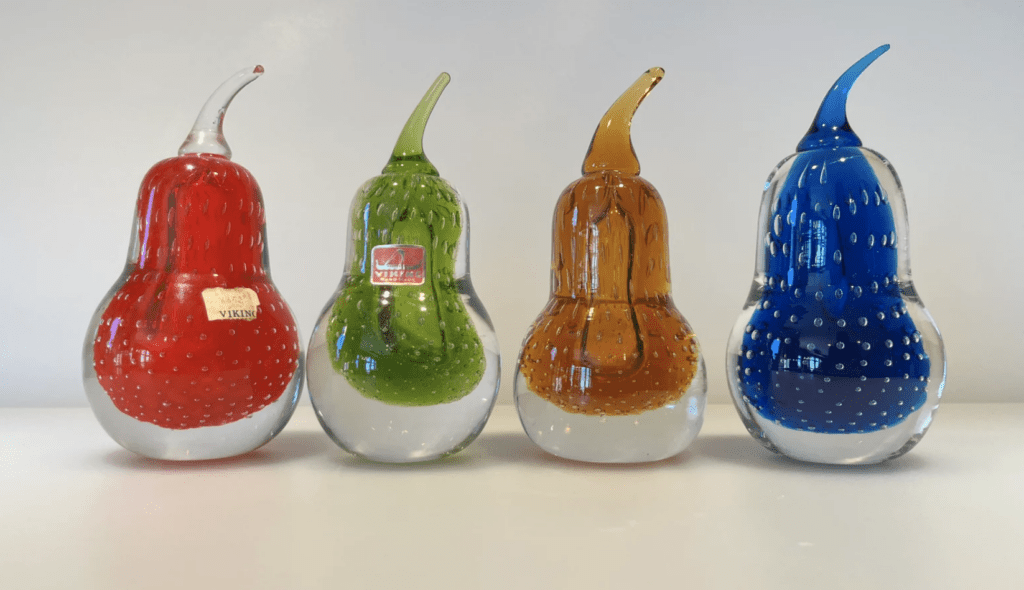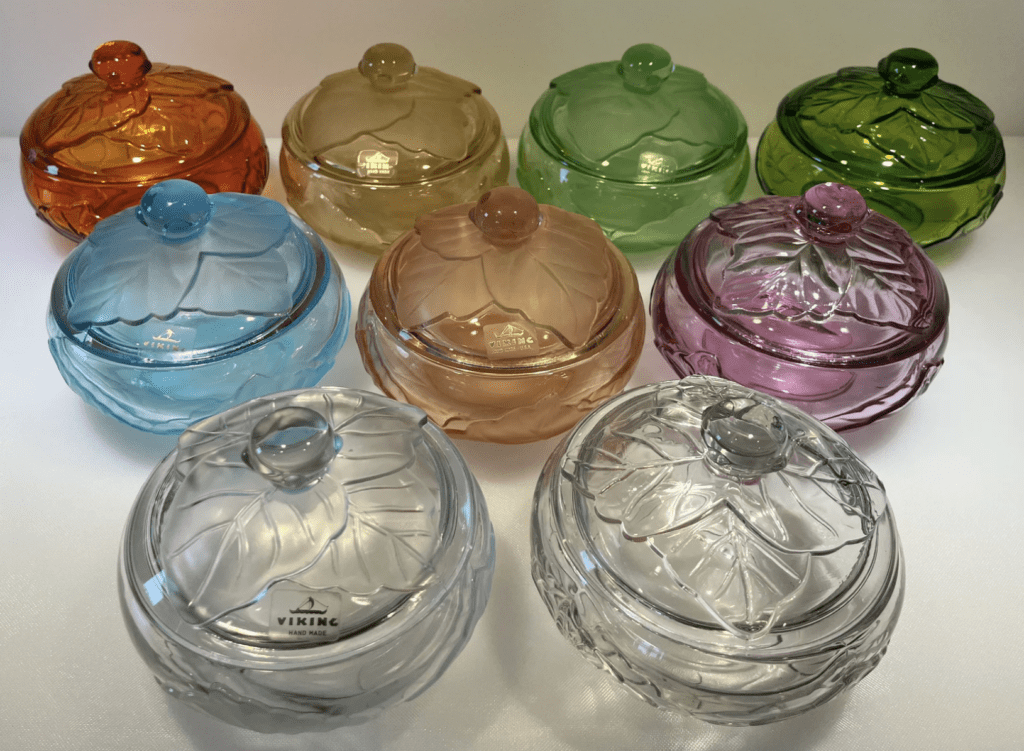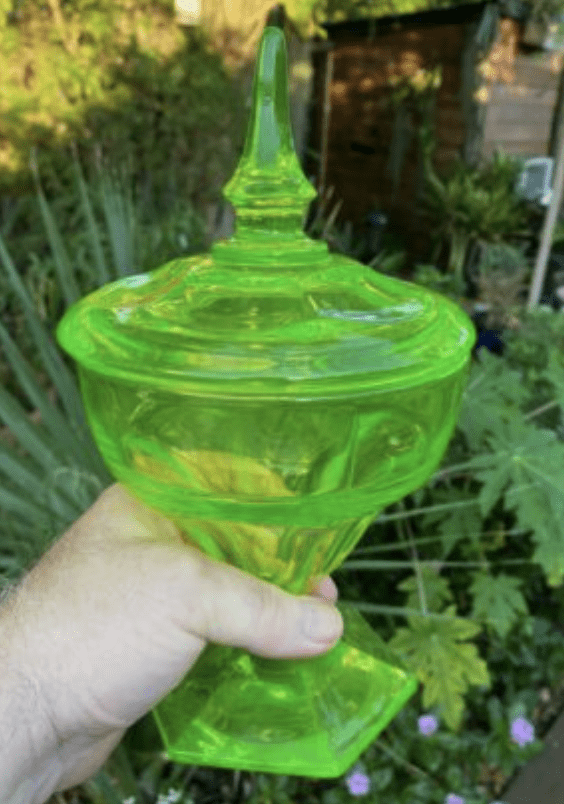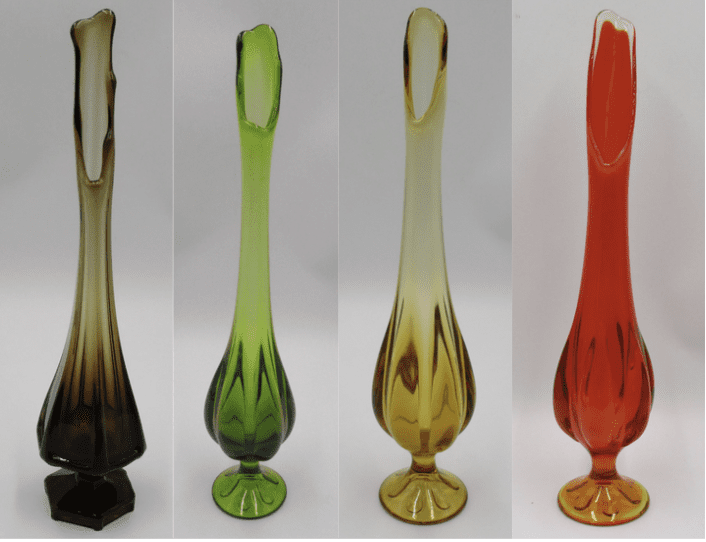There are a lot of beautiful styles of glass out there, but sometimes, it’s hard to figure out which piece is which style. Viking glass is one of these that are harder to identify (and harder to figure out the value of).
Viking glass is identified by serious collectors through the color and shape of the glass. Viking glass typically has a pedestal on the bottom. The glass color is often vibrant. Viking Glass is typically valued at $50, but it can be much more valuable depending on the size and color of the piece.
Below we will learn more about Viking glass, how to determine its value, and how to identify it.

What is Viking Glass?
The term “Viking Glass” usually refers to the Viking Glass Company’s “Epic” line of glassware. It was produced from the 1950s to the 1980s. Viking glass has several different designs and bright colors. In addition to this, Viking glass comes in a variety of shapes, and the shapes aren’t just different kinds of dishes. There are also animal figurines made from Viking glass.
However, Viking glass is generally pretty difficult to spot. The company preferred using paper tags and stickers to mark their products instead of stamping the glass directly, so people usually identify pieces of Viking glass by the colors. (Source)
The Origin of Viking Glass
The New Martinsville Glass Company was established in 1900. It did pretty well, until the Great Depression struck, plunging the company into grave financial trouble. It seemed like the company would end up closing its doors until it was saved by Silver Glass Company. This company was based in Meriden, Connecticut in 1938. They restructured and merged their companies, and then renamed the company Viking Glass Company in 1944.

The name came from the popularity of Scandinavian glass encroaching on the glass market. Business boomed through the 50s, up until the company closed in 1984. However, soon the company was reopened by Kenneth B. Dalzell, who formed the Dalzell-Viking Glass Company.
He tried to revive the company, adding several 1990s colors and traditional patterns to the existing mix of colors and patterns used in Viking glass before this point. Though this worked for a few years, the company closed for good in 1998. (Source)
Assessing the Value of Viking Glass
The value of a piece of Viking glass depends on how rare the piece is and how much of a demand there is for it. Generally, it’s fairly easy to find Viking glass for under or around $50. You can find luxury pieces for anywhere from $200-$1,000, depending on the rarity of the piece.
The most often recommended way to assess the value of Viking glass pieces that you may own is to talk to a glass appraiser. Glass appraisers specialize in classifying and assessing the value of antique glass. This not only includes Viking glass, but also includes depression glass, uranium glass, Carnival glass, and more.

Because Viking glass is one of the lesser-known types of antique glass, there aren’t many ways to figure out the value, aside from asking yourself these general questions:
- What condition is it in?
- What color or pattern does it use? Is this color or pattern rare?
- What shape is the piece?
- Does it have any stamps or marks that set it apart from other Viking glass?
In general, collectors use the color to identify Viking glass and its value because it is a consistent characteristic of all Viking glass. (Source)
How to Identify Viking Glass
The manufacturer preferred paper tags and stickers over stamping glass, so Viking glass pieces can’t usually be identified by stamps (although some pieces are stamped, and this would make them rarer than other pieces). Because of this, the color of the glass is the main identifier of Viking glass.
Each color began being produced in different years, making it easy to differentiate the age of the glass. Another way that Viking glass is able to be identified is by the types, styles, and characteristics of the pieces.

Color
The classic colors produced in 1951 were evergreen, amber, ebony, cobalt blue, sky blue, and ruby. These were the only colors of Viking glass available until 1953 when another set of colors was released.
These included amethyst, cherry glo, colonial blue, harvest gold, and olive green. From that point, these colors were the main ones, until the 1960s, when several more colors were added. In 1964, the colors were reduced from 30+ to these 7: amberina, avocado green, bluenique, crystal, persimmon, honey, and charcoal. (Source)
Uranium Viking glass glows in UV light, but no other colors glow. Uranium Viking glass glows because of the uranium component in the glass.

Types of Pieces
Viking glass comes in many shapes and sizes, but there are a couple of shapes that Viking glass was more traditionally made in. These include things like candlestick holders, animal figurines, fruit bowls, candy dishes, and vases. Sometimes, Viking glass would also be made into glasses or other dishes. (Source)
Styles and Characteristics
Each type of antique glass has a specific set of styles and characteristics that set them apart. This is the same with Viking glass. One easy characteristic to spot on Viking glass is the handkerchief-styled edges. These mimic the folds of a handkerchief as it spills over your hands.
More easy identifiers to find are the dramatic, elongated lines that characterize taller pieces of Viking glass. When the piece was designed to be tall, it was constructed to have a delicate, tapered, almost flute-like appearance. Pieces that are most likely to have these are things like candlestick holders, vases, and even animal figurines. Swung glass vases like the ones below are still a very popular collectible today.

Remember the way the colors of Viking glass changed over the years? This is another great way to identify Viking glass. Using the colors to decide whether or not a piece is Viking glass and to decide how much the piece is worth is a common practice. (Source)
It is such a common practice that collectors of Viking glass generally rely on the color of a piece more than anything else.

